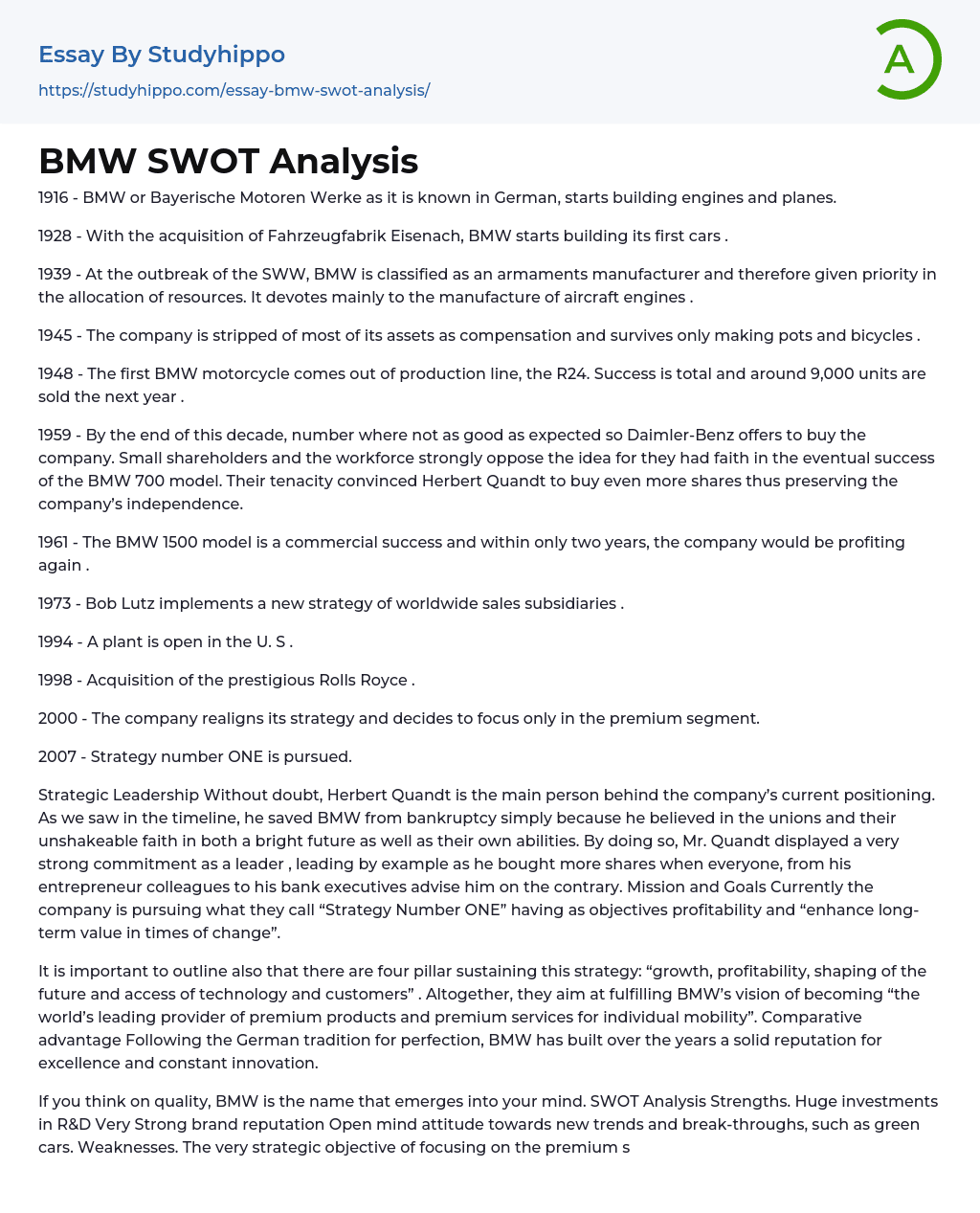BMW stands for Bayerische Motoren Werke in German, and the company started manufacturing engines and aircrafts in 1916.
In 1928, BMW began manufacturing its first cars with the purchase of Fahrzeugfabrik Eisenach.
At the onset of World War II in 1939, BMW is categorized as a weapons manufacturer. This leads to preferential resource allocation and a primary emphasis on producing airplane engines.
In 1945, the company loses a large portion of its assets as compensation, leading to its survival primarily by producing pots and bicycles.
The R24, the first BMW motorcycle, was produced in 1948 with immense success, selling approximately 9,000 units in the following year.
In 1959, Daimler-Benz made an offer to purchase the company because of its disappointing performance. However, this proposal faced strong resistance from both small shareholder
...s and employees who had faith in the potential success of the BMW 700 model. Their unwavering determination convinced Herbert Quandt to increase his shareholdings, thereby securing the company's autonomy.
The BMW 1500 model achieves great success commercially in 1961, leading to the company's return to profitability within a span of just two years.
In 1973, Bob Lutz puts into practice a fresh approach of establishing worldwide sales subsidiaries.
In 1994, a plant was opened in the United States.
1998 - The acquisition of the renowned Rolls Royce occurred.
In 2000, the company modifies its strategy and opts to concentrate solely on the premium segment.
In 2007, Strategy number ONE is pursued.
The current positioning of the company is driven by Herbert Quandt, who demonstrated strategic leadership. H
saved BMW from bankruptcy by trusting in the unions and their belief in a promising future and their own capabilities. As a committed leader, Mr. Quandt purchased more shares against the advice of fellow entrepreneurs and bank executives.
Currently, the company's mission and goals revolve around pursuing "Strategy Number ONE," which seeks to attain profitability and enhance long-term value amidst changing times.
The text emphasizes the four pillars that sustain BMW's strategy: "growth, profitability, shaping of the future, and access to technology and customers." These pillars are crucial for BMW to achieve its vision of becoming the leading provider of premium products and services for individual mobility worldwide. Furthermore, BMW's commitment to perfection, a characteristic of German tradition, has established their strong reputation for excellence and continuous innovation.
BMW is a renowned brand known for its quality and strong reputation. They invest heavily in research and development and are open to embracing new trends like green cars. However, their focus on the premium sector limits their growth potential due to affordability constraints. Additionally, producing luxury vehicles in small quantities prevents them from benefiting from economies of scale, leading to high costs.
BMW's production plants in Germany are influenced by high wages, which can be seen as both an opportunity and a threat. The rising oil prices are expected to increase the demand for electric, hybrid, or fuel efficient cars - an area that BMW specializes in. Additionally, new emission regulations will benefit the company as cars need to be more efficient in their oil consumption. BMW already has one of the highest standards in the world and does not require further
investments to develop necessary technology.
Nevertheless, strong competition from top global brands like Lexus, Mercedes Benz, Porsche, and Audi poses a threat to BMW.
BMW, one of the top 10 automakers globally, has potential for growth due to currency fluctuations, an unrecovered economy, and limited strategic integration. Despite its strong reputation and competitive position, BMW still needs to make advancements. The company follows a German tradition of strong leadership and centralized operations based in Germany. Enhancing its cost structure can be achieved by fostering collaboration between functional level managers and business level managers in strategy design. This collaborative effort would enable them to effectively address each other's requirements.
This combination, coupled with decentralized planning, will offer increased flexibility to address dynamic market conditions. However, to address the company's main weakness, which is low strategic integration, BMW should consider seeking agreements or purchasing companies that cater to other segments in the market, such as mid-price.
BMW's decision to enter various market segments is a strategic measure aimed at reducing reliance on a profitable yet limited sector. Moreover, BMW's substantial investment in research and development has established it as an industry leader in environmentally friendly technology. In light of the worsening effects of global warming and pollution, we strongly believe that embracing green technology is crucial for the future. As other nations are likely to follow suit due to growing environmentally conscious consumers, BMW should take the initiative in spearheading this movement.
- Renault essays
- Truck essays
- chrysler essays
- The city essays
- Racing essays
- Adidas essays
- Amazon essays
- Apple essays
- Bmw essays
- British Airways essays
- Burger King essays
- Coca-Cola essays
- Company essays
- Costco essays
- Dell essays
- Ebay essays
- Enron essays
- Facebook essays
- Ford Motor Company essays
- Gap essays
- General Motors essays
- Google essays
- Honda essays
- Ibm essays
- Ikea essays
- Intel essays
- Iphone essays
- Johnson and Johnson essays
- Kellogg essays
- Key essays
- Kfc essays
- Mcdonald's essays
- Microsoft essays
- Myspace essays
- Nestle essays
- Netflix essays
- Nike essays
- Nokia essays
- Pepsi essays
- Pepsico essays
- Red Bull essays
- Ryanair essays
- Samsung essays
- Sony essays
- Southwest Airlines essays
- Starbucks essays
- Supermarket essays
- Tesco essays
- Toyota essays
- Twitter essays




